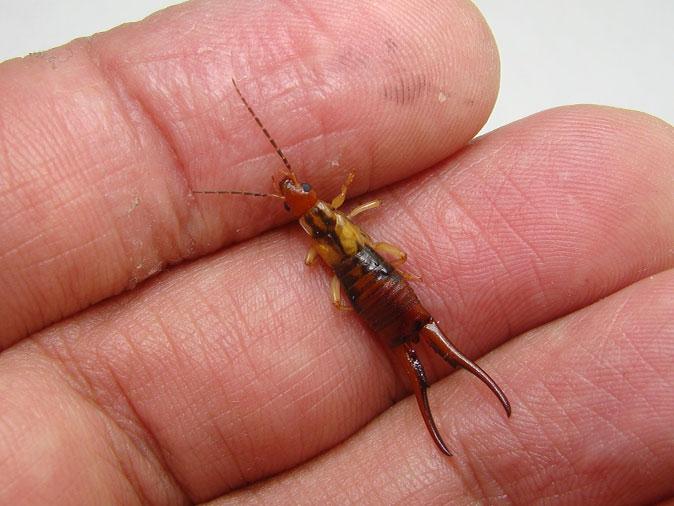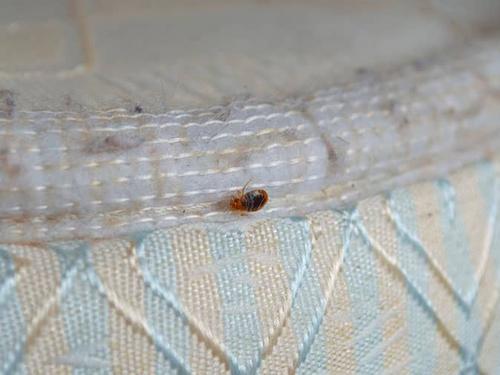What Does an Earwig Look Like?
While you may know them as a “pincher bug”, earwigs are an insect easily recognized by their long, smooth bodies and pair of appendages at the tip of their abdomen called “cerci”. Pincer-like in appearance, the cerci are fairly straight on female earwigs and tend to be more curved on the male of the species.
Earwig Identification at a Glance:
- Size: ~5/8 inch long (sometimes larger)
- Color: Dark brown to reddish-brown
- Body: Smooth, elongated
- Pincers (cerci): Straight in females, curved in males
- Wings: Two pairs of wings, with their hind wings usually folding underneath their front ones

When are earwigs most active?
Earwig Life Cycle & Habits
Understanding the life of an earwig can help you figure out why they show up inside your home. Earwigs start life as tiny eggs buried in moist soil. In the spring, the eggs hatch into nymphs (small versions of the adult bugs) and grow through several stages before reaching full size. Most earwigs you see indoors are adults searching for food or shelter.
These insects are mostly nocturnal, meaning they like to hide during the day in dark, damp areas and come out at night to feed. They prefer cool, moist environments, which is why you often find them in basements, crawl spaces, or under damp piles of leaves and mulch. By knowing their habits, you can better predict where they might appear and take steps to keep them out.
Are Earwigs Dangerous?
Nope, not really. While an old myth suggests these insects enter human ears to burrow into the brain and lay their eggs, there is no evidence to support it.
Earwigs may try to pinch if threatened, but they are not considered dangerous to humans or pets. They are nuisance pests typically found in basements and other cool, damp areas.
Damage Earwigs Can Cause
While earwigs aren’t a threat to people or animals, they can still be a nuisance and occasionally cause minor damage. The good news is that the damage is generally minor and mostly aesthetic.
Earwigs feed on decaying plant material but nibble on flowers, vegetables, and fruits in gardens or potted plants. If they get inside, they may also chew on leaves or stems of indoor plants.
Signs of an Earwig Infestation
Earwigs are mostly harmless, but having them in your home can be unsettling. Here are a few signs that you might have an earwig problem:
- Seeing live bugs at night: They’re nocturnal, so spotting them during the day usually means they’re looking for hiding spots.
- Sheds or skins: Like other insects, earwigs molt as they grow, so you might notice tiny leftover exoskeletons.
- Tiny droppings: Small, dark specks near damp corners or under plants can be a clue.
- Indoor plant damage: If your houseplants show signs of chewing or decaying leaves, earwigs may be the culprit.
Noticing even a few of these signs early can make controlling them much easier.
Are Earwigs Invading Your Colorado Home? Here’s Why
If you’re spotting earwigs inside your home, you’re not alone. These pincher bugs usually live outdoors in damp areas, but they can migrate indoors when the temperature rises or when moisture levels drop outside. Once inside, they look for dark, humid hiding spots—like bathrooms, basements, under rugs, potted plants, or stacks of newspapers—making your home their temporary retreat.
Earwigs are nocturnal, which means they usually come out at night to feed on decaying plant material and even other insects. Occasionally, they hitch a ride inside on items like lawn furniture, newspapers, or potted plants.
While they aren’t dangerous, these pests can be a nuisance. The good news? Understanding why they’re invading is the first step to keeping them out of your basement, protecting your home, and stopping pincher bugs now.
How Can I Get Rid of Earwigs?
If you are having problems with earwigs in your home, EnviroPest can help. Our home pest control program, available in Denver, Boulder, Colorado Springs, Loveland, and throughout NoCo, targets household pests, including earwigs.
Earwig Prevention Tips
The best way to prevent an earwig problem is to keep these pests out by fortifying the exterior of your home. We recommend:
- Sealing any cracks and crevices found in your home’s foundation
- Caulking gaps around exterior windows and doors
- Repairing any damage to siding or roof shingles.
- Trimming trees or shrubs so that they don’t touch the exterior of your home or building.

Testimonials
GETTING STARTED IS AS EASY AS 1-2-3
REQUEST QUOTE & SCHEDULE



